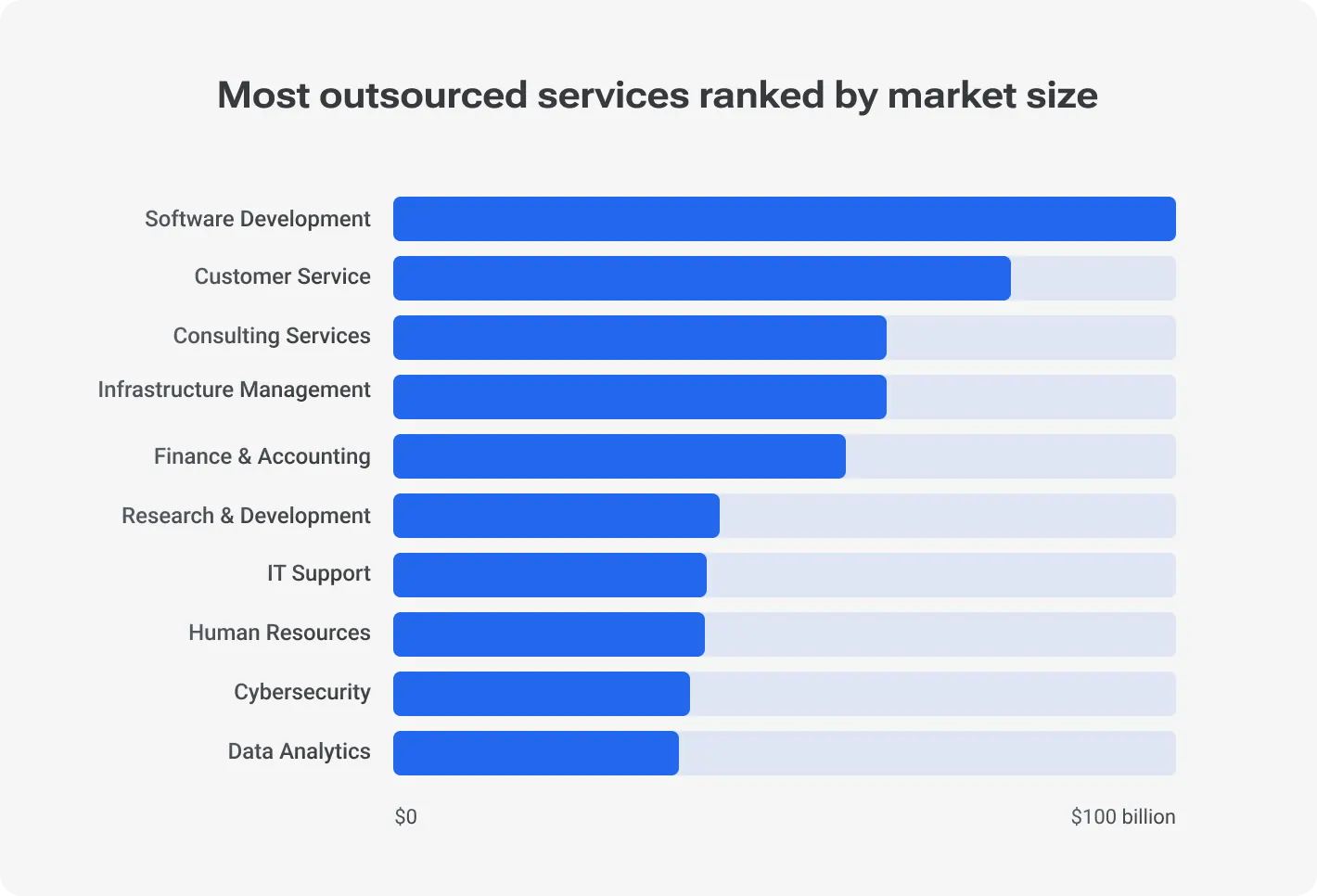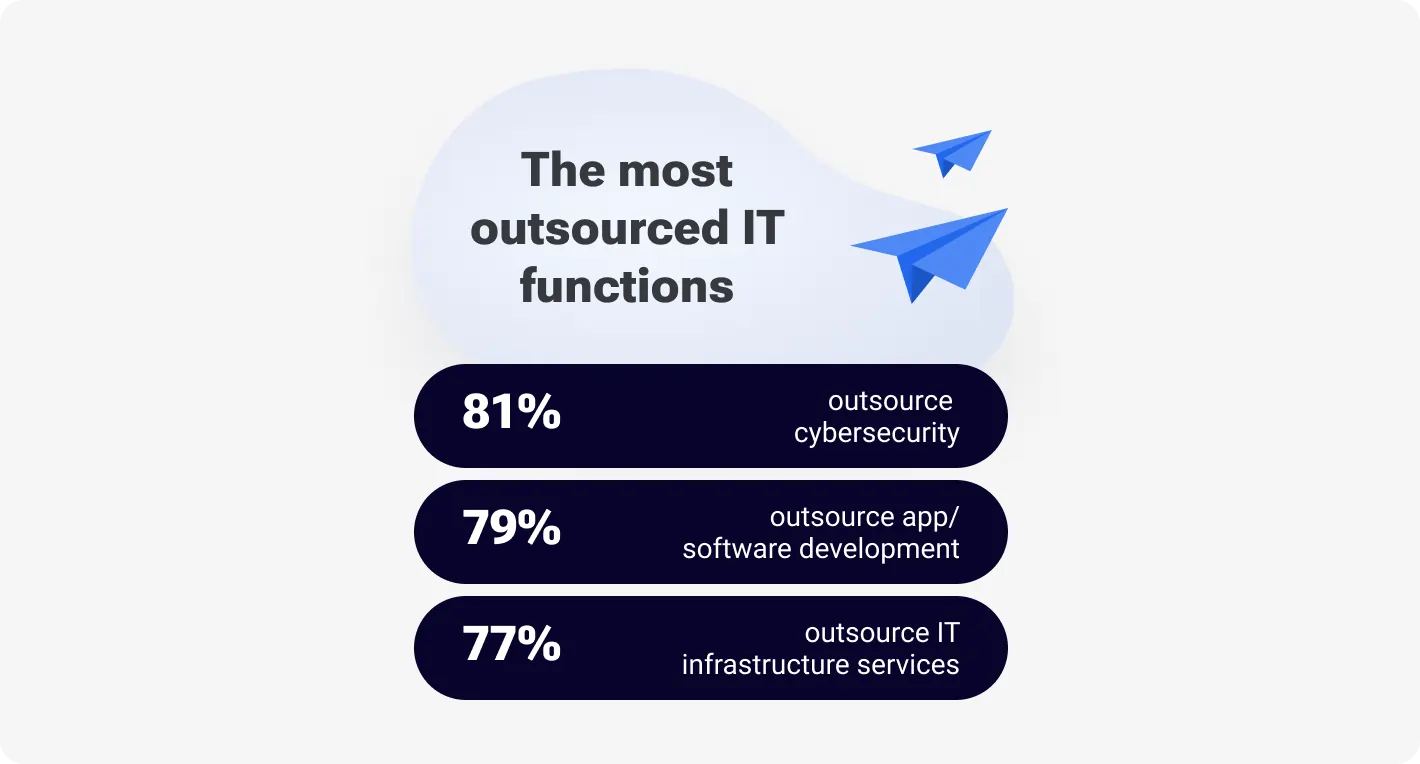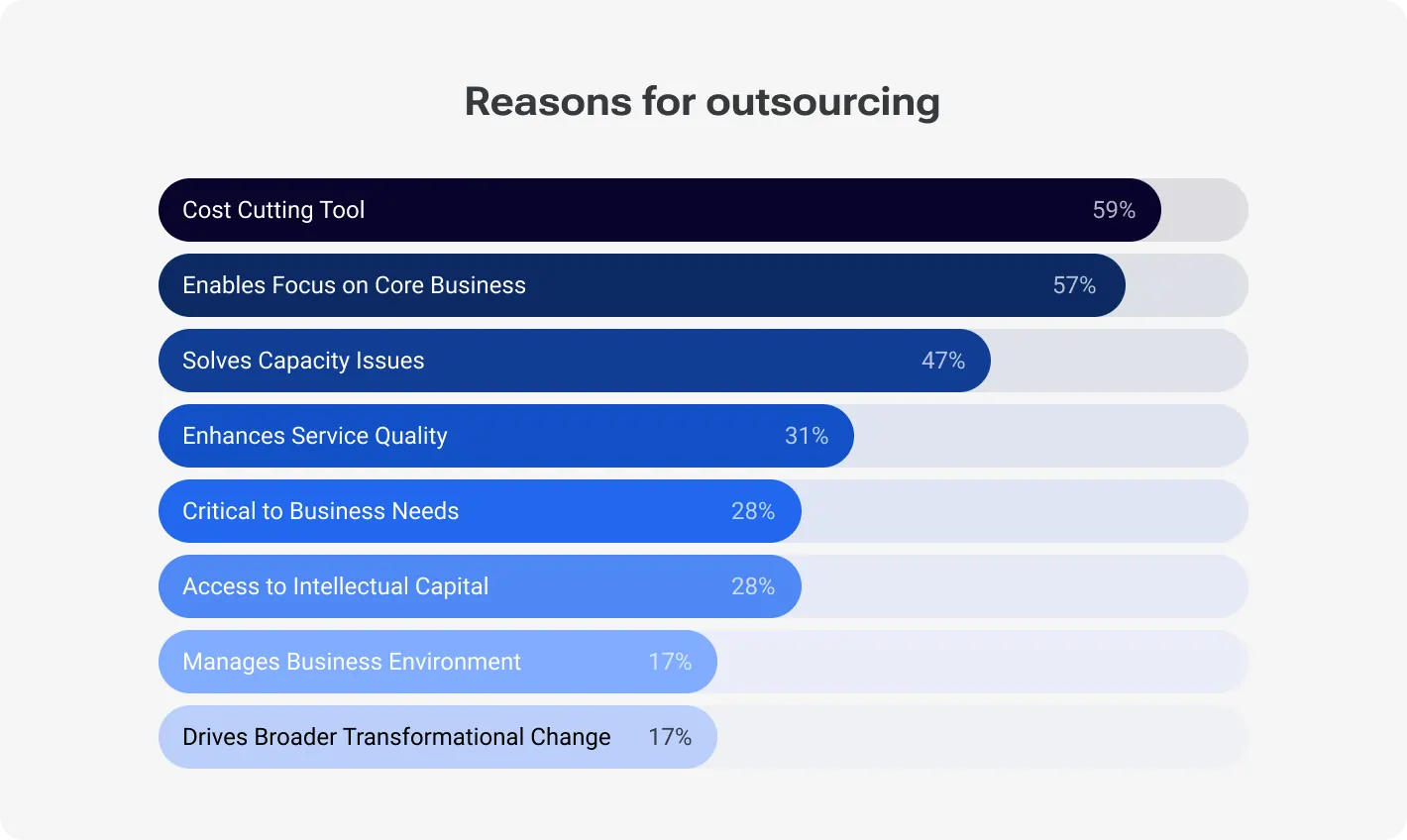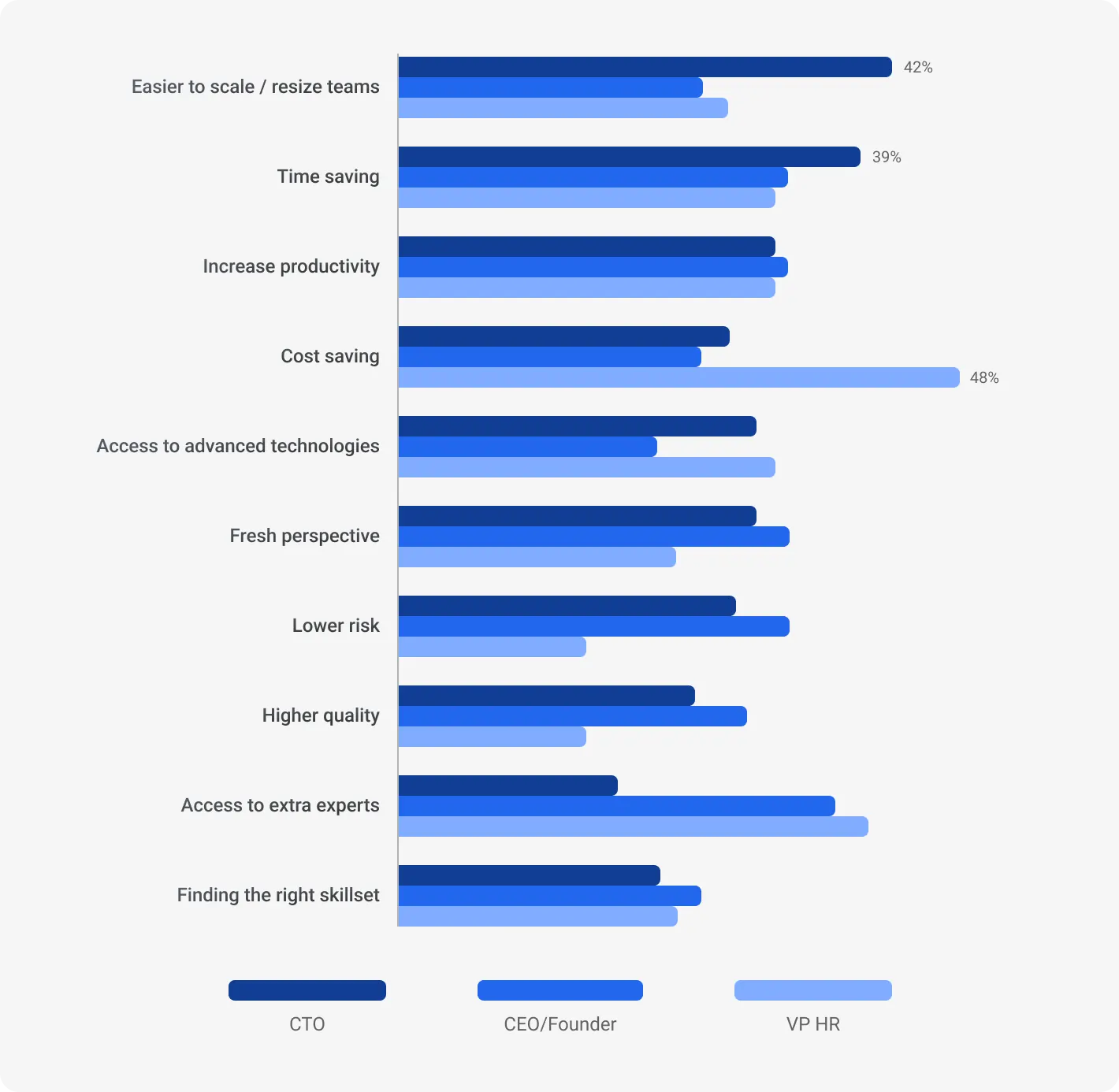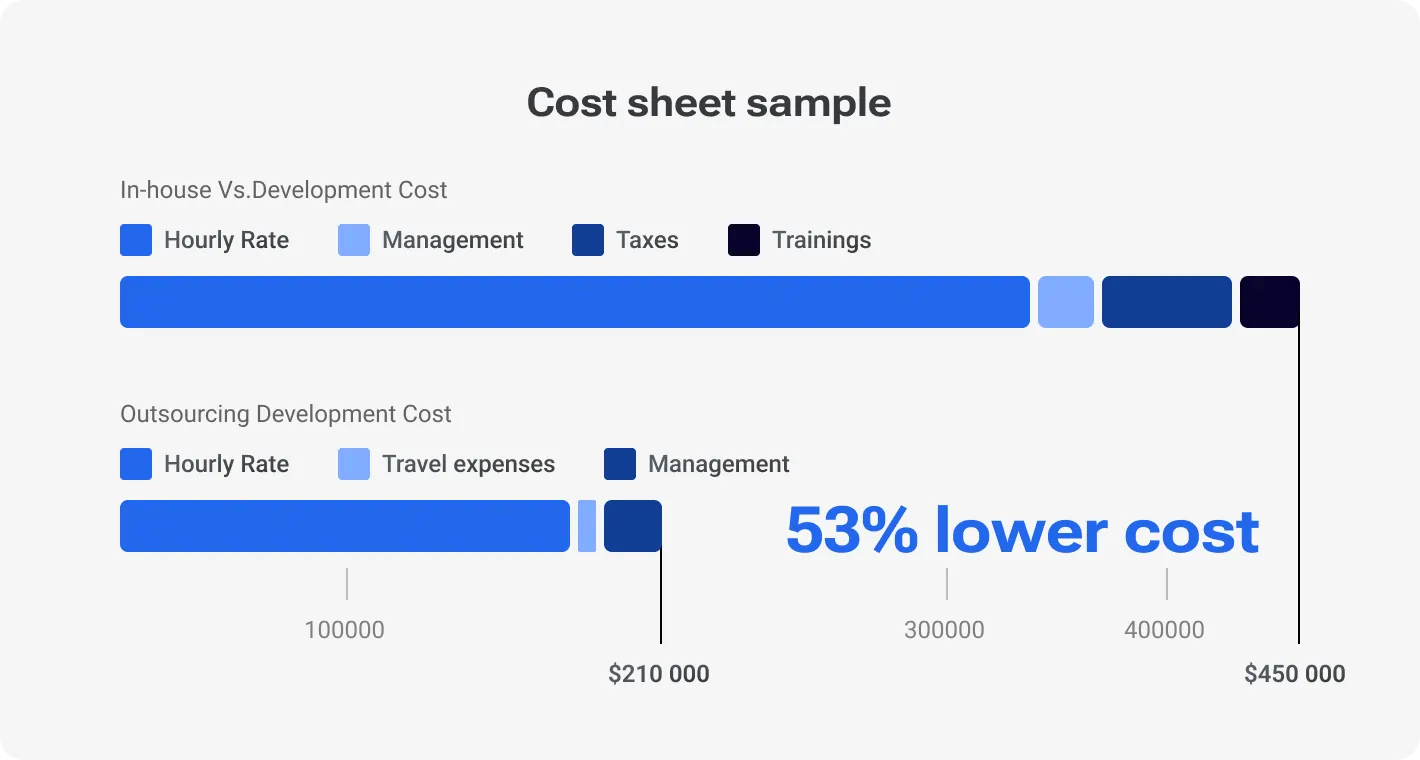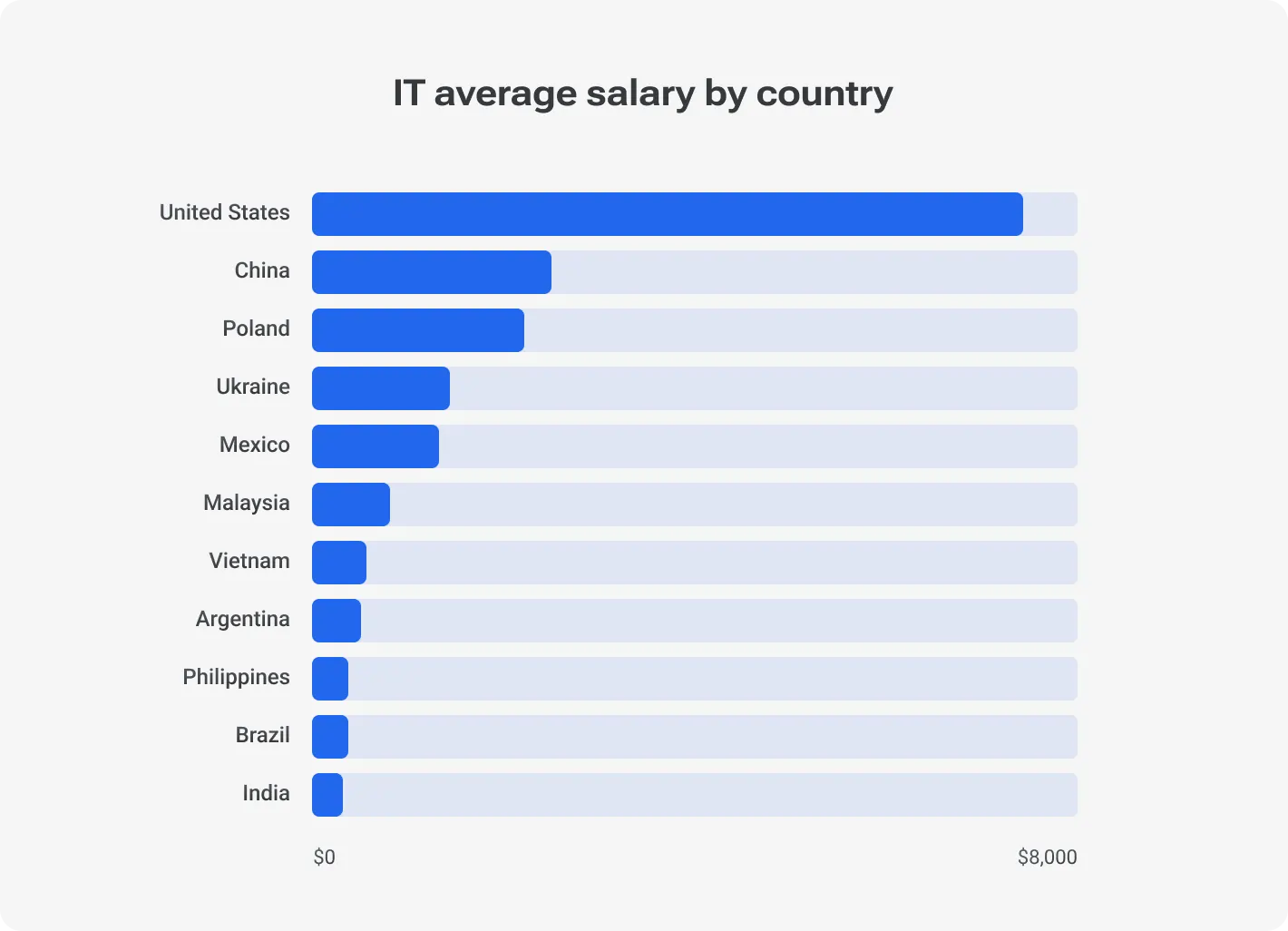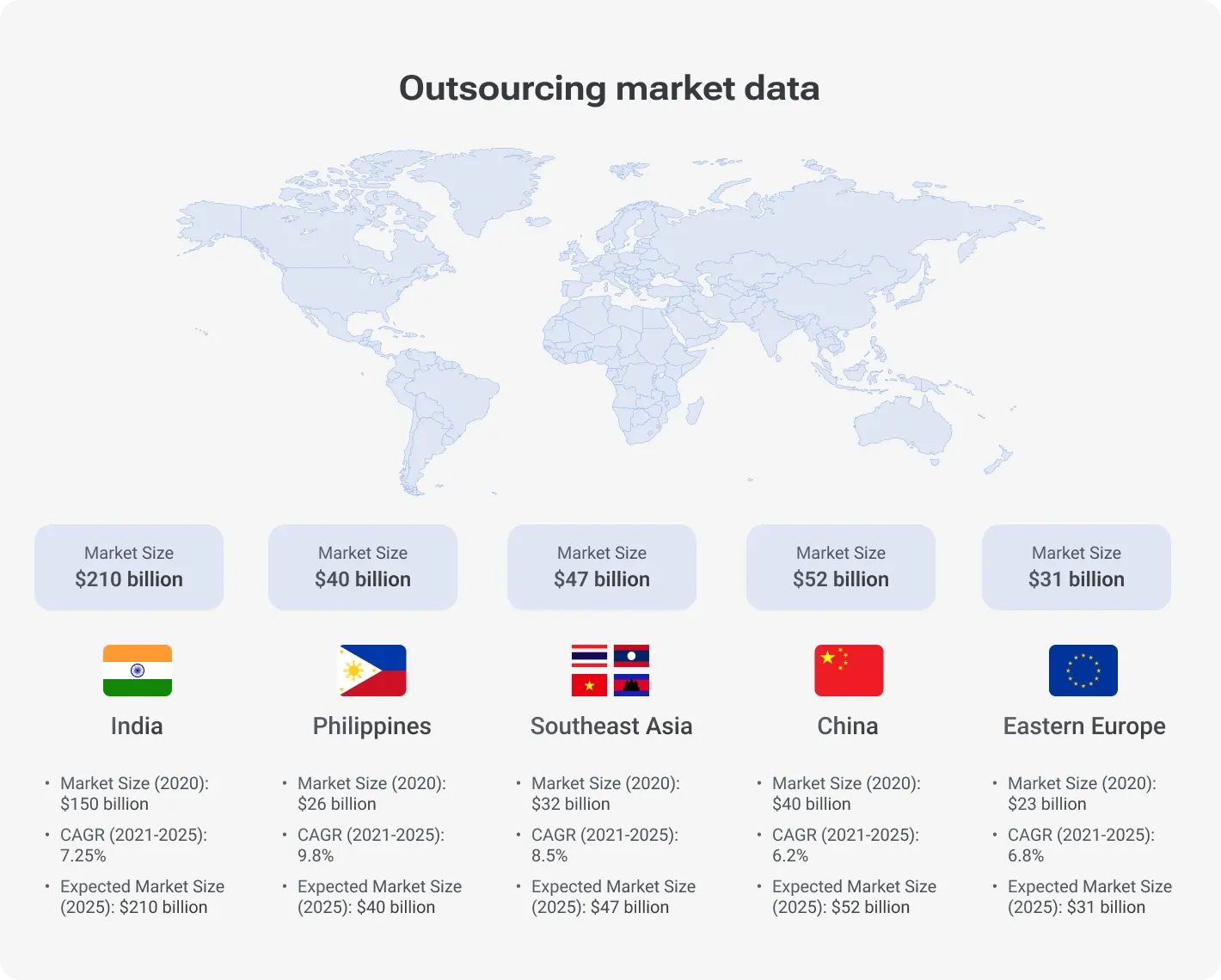In 2025, companies face numerous problems, such as lack of in-house expertise, talent shortage and negative ROI. To save time and effort, they outsource work. Figures prove it, just last year the world spent $731 billion on outsourcing. This is a big jump as the number grew 22% from the previous year. Many big successful companies use outsourcing, including 92% of the G2000 companies.
There are many reasons why companies choose software development outsourcing – faster time-to-market, better productivity, and cost savings of 15-30%. If you want to successfully outsource and get all these perks, you need a good outsourcing business strategy. A strong and flexible outsourcing strategy is key for success in 2025 and beyond.
Defining your outsourcing goals and strategy
First things first, you need a clear understanding of why you want to outsource and what you want to achieve. This is where your outsourcing goals and strategy come in.
End-to-end solutions with predictable budgets, a time-to-market advantage with budget savings of up to 50%
Internal assessment
Before you decide to outsource any task, take a good, hard look at your own company. This is called an internal assessment. It helps you figure out what you're good at and where you might need help. Think of it like figuring out what you're strong in before you decide to ask for help.
Knowing your strengths and weaknesses makes your outsourcing process much easier. You can find the right help to make sure how to make outsourcing successful for you.
Skills & capabilities
What can your team do really well? Are there areas where they need more training or experience? For example, do you have a strong in-house software development team? Or would it be better to software development outsource some projects? You should access the following:
Identify core team strengths (e.g., specific technologies, methodologies).
Determine if specialized expertise is needed (e.g., AI, cybersecurity).
Analyze the cost-benefit of each option.
Resources
What tools, technology, and money do you have to work with? Do you have the latest software development tools? If not, is it worth it to invest, or should you look into how to outsource software development and avoid the costs? To do it effectively, do the following:
List all existing software development tools and technologies.
Assess the "up-to-dateness" of the tools and technologies.
Research if newer/better tools are needed (and their cost).
Plan for necessary investments in technology.
Processes
How do you do things now? Are your processes efficient? If you plan to successfully outsource software development, will the outsourcing company be able to follow your internal processes, or do you need a different approach? To answer these questions, do the following:
Document existing project management processes (e.g., Agile, Waterfall).
Assess the efficiency of current workflows.
Identify areas for streamlining or improvement.
Needs
Today, 64% of outsourced services are related to software application development. So, what tasks are taking up too much time or are outside your core business? Consider, how to outsource some particular IT services or the whole IT department? Are you constantly behind on projects? Maybe you lack specific expertise for IT development.
Remember – outsourcing is easier when you know what you need. Outsourcing strategies must be tailored to your business. With this internal assessment, you'll be on your way to successfully outsource IT development.
Setting clear expectations
A study by McKinsey & Company found that companies with specific objectives for outsourcing projects are 40% more likely to achieve their targets than those without well-defined goals. Why else clear expectations matter:
Clearly defined expectations align the goals of both parties, reducing the risk of miscommunication and misunderstandings.
Setting clear expectations helps identify potential risks early on, enabling proactive measures to mitigate them.
Regular updates, progress reports, and open communication are facilitated by clearly defined expectations.
Clear expectations foster a sense of ownership and encourage both parties to work towards common goals.
For example, your goal is to develop a mobile application within 6 months with specific features and functionalities. Then your expectations could be outlined like that:
Regular progress updates every 2 weeks,
Adherence to agile development methodologies,
Testing and quality assurance protocols,
Outsource software development to a team with expertise in mobile app development.
As a result, the project is completed on time, meeting all the specified requirements and expectations, which is a great example of how to successfully outsource software development.
You can use some of the best practices for setting clear expectations within your outsourcing relationships, with frameworks like KPIs, OKRs, and SMART goals for greater precision and success.
This proactive approach helps align your business objectives with the outsourced team's actions, minimizing risk, and increasing the likelihood of achieving successful outsourcing outcomes.
Identify key drivers: Cost savings, scalability, innovation
The decision to outsource is often driven by a few primary, interconnected factors that promise significant benefits for businesses of all sizes. Understanding these key drivers – cost savings, scalability, and innovation – is fundamental to crafting a successful outsourcing strategy.
Cost savings
This is frequently the most immediate and compelling driver. Around 70% of businesses save on their expenditure using outsourcing, as it allows companies to:
Reduce labor costs: By leveraging lower labor rates in different geographical locations.
Minimize overhead expenses: Eliminating the need for office space, equipment, and benefits associated with internal staff.
Improve efficiency: Outsourced teams, often focused on specialized tasks, can be more efficient and productive.
Control capital expenditures: Avoiding significant investments in infrastructure or technology.
Scalability
Outsourcing offers businesses the flexibility to scale their operations up or down quickly and efficiently, adapting to market demands without the complexities of hiring and firing internal staff. This agility allows companies to:
Rapidly expand capacity: Easily access additional resources and expertise when needed.
Respond to seasonal fluctuations: Adjust resources based on demand without long-term commitments.
Focus on core competencies: Allocate internal resources to strategic initiatives while outsourcing non-core functions.
Reduce risk: Mitigate the financial and operational risks associated with building and maintaining in-house teams.
Innovation
Outsourcing can unlock new opportunities for innovation by:
Accessing specialized expertise: Tapping into a global pool of talent and skills that may not be available internally.
Accelerating time to market: Leveraging established processes and technologies to quickly develop and launch new products and services.
Fostering creativity and fresh perspectives: Bringing in external insights and ideas to challenge existing assumptions and drive innovation.
Focusing on strategic initiatives: Freeing up internal resources to concentrate on research, development, and strategic planning.
These three drivers are often interconnected and mutually reinforcing. For example, cost savings achieved through outsourcing can free up capital to invest in innovation. Scalability allows companies to quickly adapt to new market opportunities, accelerating the development of innovative products and services. The strategic interplay between these drivers highlights the potential of outsourcing to transform businesses, improve efficiency, and drive competitive advantage.
When to outsource: Strategic vs. operational outsourcing
ManpowerGroup shows that 75% of employers in the US need help with finding suitable talent. Outsourcing offers a solution to this, but the choice between strategic and operational outsourcing is crucial.
Strategic outsourcing
Operational outsourcing
Long-term business transformation, strategic advantage
Short-term operational efficiency, cost reduction
Short-term to medium-term (less than 3 years)
Broad; Entire functions, core processes
Narrow; Specific tasks, processes, departments
- Access to specialized expertise/technology
- Significant cost reductions (economies of scale)
- Improve business agility and innovation
- Focus internal resources on core competencies
- Reduce operational costs
- Free up internal resources
- Improve the quality/speed of specific tasks
- Address resource constraints/skill gaps
- Long-term strategic planning
- Desire to fundamentally reshape the business
- Operational needs, cost reduction, specific improvements
- Address temporary resource constraints
High-level: Executive/Board
Higher (impact on core business)
Lower (focused on specific tasks)
Strong partnership, high collaboration, high trust
Complex, detailed, high degree of management
Fundamental change in how business operates, may involve asset transfers and employee changes
Focuses on improving existing operations, less impact to the core business operations
Choosing the right outsourcing model
Now that you have decided to outsource, selecting the right outsourcing model is crucial for success. A well-structured outsourcing model helps ensure that your business goals are achieved, and risks are minimized. There are several outsourcing models, each with its pros and cons, to consider.
Project-based outsourcing: best for short-term needs
Project-based outsourcing involves outsourcing specific, well-defined projects, usually with a set start and end date. This model offers a solution for short-term needs, allowing businesses to leverage external expertise and resources without committing to a long-term relationship.
Focused expertise: You gain access to specialized expertise and skills for specific tasks.
Limited scope: Suitable only for well-defined projects with specific objectives.
Cost-effective: Projects can be outsourced at a fixed price, making budgeting easier, or on a time-and-materials basis.
Potential for misalignment: Requires clear project specifications and communication to ensure understanding.
Scalable: Easily scale up or down as needed based on project scope.
Limited long-term benefits: Does not provide the same strategic advantages as long-term outsourcing agreements.
Flexibility: Quick turnaround times and flexibility to adapt to changing project requirements.
Integration challenges: Integration of the project outcomes into the business may be difficult.
Reduced risk: Lower risk than outsourcing entire functions, as it is a smaller scope.
Management demands: Requires careful management of the project.
Project-based outsourcing is the best option for limited-time projects with a defined scope, clear deliverables, and measurable results. Some examples are website development, software upgrades, or temporary data analysis.
Dedicated teams & staff augmentation: when flexibility matters
The tech industry faces significant talent shortages, with a McKinsey survey revealing that 69% of companies struggle to hire data engineers, 78% have difficulty finding AI scientists, and 75% face challenges in recruiting machine learning engineers.
To address these challenges, outsourcing software development presents a compelling alternative to in-house development. A key advantage is cost efficiency, as leveraging a dedicated team can potentially reduce development expenses by up to 53%. Furthermore, according to the State of Tech Staffing report, CTOs recognize the scalability and adaptability of dedicated software development teams as their primary benefit (42%), closely followed by time savings (39%).
10 questions to ask your software development outsourcing vendor
Both dedicated teams and staff augmentation are valuable software development outsourcing models, particularly when flexibility is crucial. They offer different approaches to adding resources to your team, each with its own set of benefits and drawbacks. These models offer numerous benefits, including:
- Focused, cohesive team dedicated solely to your project.
- Potentially higher initial cost compared to staff augmentation for smaller projects.
- Enhanced collaboration and communication due to a unified team structure.
- May require more upfront planning and commitment due to the dedicated nature of the team.
- Easier to build a strong team culture and shared understanding of project goals.
- Can be less flexible for short-term, highly variable projects.
- Access to a specialized and potentially broader range of skills than in-house teams.
- Dependency on the outsourcing provider for technology expertise and knowledge transfer.
- Teams can adapt and integrate quickly to your existing processes.
- Potential for communication barriers if language or time zone differences exist (though manageable).
- Cost-effective for larger and long-term projects (up to 53% cost reduction compared to in-house).
- Requires a clearly defined scope and requirements to minimize scope creep and associated cost increases.
- Faster time to market due to experienced teams already in place and optimized workflow processes.
- Difficult to replace the team quickly if the outsourcing provider is a bad match
- Ability to easily scale the team up or down based on project needs (as cited by CTOs in the report).
- Requires active management and communication with the provider to ensure optimal performance and adaptation.
- The team is fully concentrated on the client's project.
- There is no direct control over the team.
For example, if you already have a software product and need ongoing maintenance, bug fixes, and feature enhancements. You can outsource the entire maintenance process to a dedicated team. This team learns your code like the back of their hand and can correct problems and implement improvements in advance. The benefits here are consistency and a lower learning curve in the long term.
Or you have a small on-premises maintenance staff for software, but sometimes you need some temporary extra help during a peak period (e.g., end of quarter, after release, etc.). Staff augmentation fills the gap. You can also use it during a spike in customer support inquiries. You're directly managing the augmented staff, integrating them into your regular maintenance processes.
Full-service software development outsourcing: for end-to-end solutions
Full-service software development outsourcing refers to the outsourcing of all or most aspects of a business function or service across the entire lifecycle, including strategy, design, implementation, and ongoing management. 20% of US companies outsource all their IT support to other countries. This model is designed for businesses seeking comprehensive, end-to-end solutions for their IT needs. The scope of full-service outsourcing includes:
Strategy formulation: The outsourcing provider helps develop a strategic plan for the business function or service, including goals, objectives, and key performance indicators (KPIs).
Planning: The provider creates a detailed plan for the function or service, including technical specifications, timelines, and budgets.
Implementation: The outsourcing provider delivers the project or service, including all necessary development, configuration, testing, and deployment activities.
Ongoing management: The provider handles ongoing management and maintenance of the function or service, including monitoring, reporting, and continuous improvement.
Let's say you're the CEO of a growing e-commerce company. You've been experiencing rapid growth and are starting to feel the strain of managing your own in-house IT infrastructure. Your team is overwhelmed with the tasks of managing your internal and customer-facing systems, handling their IT needs, including hardware, software, and cybersecurity.
You're finding that you need to shift your focus to other tasks, such as product innovation and customer service. So, you outsource your IT infrastructure to a provider that takes end-to-end responsibility for the management of your entire IT infrastructure. By working with an IT provider, your e-commerce company can offload the entire burden of managing the IT systems, freeing up internal resources and reducing risks. The provider manages everything from the hardware to the cybersecurity, allowing the company to focus on their core competencies.
Hybrid approaches: combining models for maximum impact
When implementing an outsourcing model, companies often struggle to decide whether to adopt an entirely external or internal approach. However, a hybrid approach can offer numerous benefits by combining the strengths of different models. For example, staffing models:
Approach
Key features
Benefits
Drawbacks
In-house staff + outsourcing
- Maintaining an in-house team for core competencies and strategic tasks.
- Combines the benefits of internal expertise with the flexibility and scalability of outsourcing.
- Requires careful coordination and communication between in-house and outsourced teams.
- Risk of diluted company culture.
- Outsourcing specific tasks, projects, or specialized skills.
- Allows focus on core business and strategic goals.
- Potential for vendor lock-in.
- Challenges in ensuring seamless integration and knowledge transfer between teams.
Cloud services + on-premises
- Leveraging cloud services (e.g., IaaS, PaaS, SaaS) for scalability, flexibility, and cost-effectiveness.
- Optimizes resource allocation.
- Can lead to cost savings.
- Provides scalability.
- Requires careful consideration of data security and compliance.
- Managing a hybrid infrastructure can be complex.
- Potential for increased latency.
- Maintaining on-premises infrastructure for critical systems, data security, and regulatory requirements.
- Provides more control over data and security.
- Can address regulatory compliance.
- Higher upfront investment and ongoing maintenance costs.
- Reduced scalability compared to fully cloud-based solutions.
Managed Services + project-based staffing
- Using managed services providers for routine maintenance, support, and infrastructure management.
- Reduces the burden on internal IT staff.
- Provides access to specialized expertise.
- Provides cost savings through operational efficiency.
- Vendor dependency.
- Can be less responsive to unique or unexpected needs.
- Reduced control over infrastructure and support.
- Hiring project-based staff (contractors or freelancers) for specific initiatives or temporary needs.
- Offers flexibility and agility.
- Provides access to specialized skills on a project-by-project basis.
- Can be more expensive than permanent staff.
- Requires robust onboarding and offboarding processes.
- Risk of knowledge silos.
With this combined approach, you get only the best from each of the models. You can easily optimize the budget, quickly adapt your outsourcing strategy as needed and respond to changes in the market or your internal needs, while also mitigating risks associated with outsourcing, such as cybersecurity threats or service disruptions.
Simultaneously, they outsource their cloud infrastructure to a specialized provider, allowing for scalability and cost savings. This hybrid model enables the healthcare provider to optimize resource allocation, focus on core competencies, and provide better patient services by ensuring infrastructure performance and availability.
Picking the ideal outsourcing destination
Selecting the best country to outsource to is critical. It can help you save even more money, to be specific up to $6,474/month (85% savings). To make a good choice, you need to think about a few things. One thing is how much it costs to hire workers in that place. You also need to make sure there are people with the right skills to do the job.
10 software outsourcing trends to consider in 2025
It's also important to understand the laws and rules of that country, especially when it comes to protecting your business ideas and keeping your information safe. Lastly, you should think about how easy it will be to work with people from that place, considering things like language and time differences.
Offshore, nearshore, or onshore: pros and cons in 2025
Feature
Offshore (e.g., India, Philippines, Ukraine)
Nearshore (e.g., Mexico, Colombia, Argentina)
Onshore (e.g., US, UK, Canada, Australia, Western Europe)
Lowest labor costs. Potential for significant savings on development, design, and project management.
More competitive pricing than onshore. Lower labor costs than onshore, though typically higher than offshore.
Highest labor costs. Significant investment required, especially for complex projects.
Significant time difference (e.g., 9-12 hours difference with the US West Coast). Can impact real-time communication and collaboration.
Smaller time difference (e.g., 1-3 hours difference with the US East Coast). Facilitates easier communication and collaboration.
Same or very similar time zones. Real-time communication and collaboration are straightforward.
Potential for cultural differences in communication styles, work ethics, and expectations. Requires careful management to mitigate misunderstandings.
Often shares cultural similarities, particularly for projects in the Americas and Europe. Easier cultural integration.
Highest cultural compatibility, shared language, and work ethics. Minimizes communication challenges.
Language barriers (English proficiency can vary). Can lead to misunderstandings, delays, and rework.
Better English proficiency than offshore in many cases. Fewer communication barriers.
Excellent communication due to shared language and cultural understanding.
Quality can vary significantly. Requires rigorous quality assurance processes and careful vendor selection.
Often higher quality than offshore. More emphasis on quality and adherence to best practices.
Generally, the highest quality developers. Established reputations and experience.
Large talent pool available. Access to a wide range of skills and experience.
Finding the right talent can be challenging. Requires careful screening and due diligence.
Growing talent pool with a good level of experience. Strong focus on digital transformation and technology adoption in many areas.
Talent pool may be smaller than offshore. Competition for top talent can be high.
Access to highly skilled and experienced developers. May have a more specialized skillset for certain technologies.
Competition for top talent may be high.
Potentially weaker IP protection laws in some offshore locations. Requires strong contractual agreements.
Stronger IP protection compared to some offshore locations, especially in countries with robust legal systems.
Strongest IP protection. Well-established legal frameworks and enforcement.
Travel & in-person meetings
Difficult to arrange in-person meetings due to travel distance and cost. Can hinder relationship-building.
Easier to arrange in-person meetings, particularly for nearshore locations, which can improve collaboration and trust.
Easiest to arrange in-person meetings. Facilitates strong relationships and better project oversight.
Political & economic stability
Political and economic instability in some offshore locations can impact project timelines and continuity.
Generally, greater political and economic stability than some offshore locations.
Highest political and economic stability. Minimizes project risk.
Navigating local regulations and legal requirements can be complex and time-consuming.
Easier regulatory compliance compared to offshore locations. Familiarity with Western legal standards.
Easiest regulatory compliance due to shared legal frameworks.
Top outsourcing locations
Outsourcing can be a great way to get things done faster and cheaper. But there's no one-size-fits-all answer, the best place to outsource depends on your goals. Do you want to save the most money? Need super-fast service? Or maybe you want someone who understands your culture? Let's think about what matters most to you and find the outsourcing locations that fit your needs!
Ukraine
Ukraine is quickly emerging as a strong choice for businesses looking to outsource key tech services. It excels in areas like web development, software creation, and IT support. Ukrainian outsourcing companies offer specialized services in these fields, building the country's reputation as a tech leader.
This success is fueled by a talented pool of skilled engineers, developers, and IT professionals. A strong focus on education has created a workforce that's well-versed in modern technologies and programming languages, making Ukraine a center for innovation.
While facing challenges like geopolitical issues and economic changes, Ukraine's tech sector continues to grow, thanks to the dedication of its IT community and government support for the digital economy. Companies are attracted to Ukraine due to competitive costs, high-quality output, adaptable workforce, cultural and operational agility.
Key facts about Ukraine:
Time zone: Generally 5 to 10 hours ahead of the United States, providing overlap for collaboration.
English proficiency: Over 84% of professionals are proficient in English.
Average cost: Software development costs typically range from $25-$45 per hour, with high-quality results.
Mexico
Mexico is becoming a leading location for IT services and manufacturing, drawing companies seeking competitive pricing and expertise in these areas. Mexico's close proximity to the U.S., offers the advantage of nearshoring, allowing businesses to collaborate more effectively and manage operations with ease. The country's IT industry has experienced significant growth, driven by a skilled workforce of IT professionals, software developers, and engineers.
Cost-competitive labor rates, coupled with a strong commitment to quality, further enhance Mexico’s appeal as an outsourcing destination. Whether it’s developing software solutions, managing IT infrastructure, or producing high-quality manufactured goods, Mexico offers a diverse range of services that cater to the needs of businesses looking to optimize their operations through outsourcing.
Key highlights:
Time zone: Overlaps with U.S. time zones, offering real-time collaboration
Salary: Competitive rates with an average salary for IT professionals around $15,000 to $30,000 annually, and a minimum wage approximately $7 per day
Languages: Spanish, with increasing English proficiency in business and tech communities.
Poland
Poland has firmly established itself as a premier outsourcing destination for software development. Its strong economy, geographic location, and thriving market have made it a highly sought-after choice, particularly for European clients. Recognized as the third-best country globally for investment by CEOWORLD Magazine, Poland boasts a skilled workforce, demonstrated by a 98% overall score on HackerRank. Major Polish cities like Kraków and Warsaw are recognized for their digital transformation. According to the A.T. Kearney Global Services Country Index, Poland holds 24th place in IT outsourcing attractiveness. The advantages that make Poland such a popular choice are:
Growth: The revenue in the IT Outsourcing segment of the IT services market in Poland was forecast to continuously increase between 2024 and 2029 by 1.9 billion U.S. dollars (+54.03 percent).
Talent pool: A workforce of 295,3 thousand professionals within the field of development.
Language proficiency: Approximately 70% of the population is fluent in English.
Competitive rates: Average hourly pay ranges from $25-$50 per PayScale.
Popular languages: Java, PHP, Python, Ruby, and Shell are widely used.
The Philippines
The Philippines, as a leading player in the outsourcing market, showcases a remarkable capability to adapt to the needs of multinational companies. Due to its strong market and economy, Poland is a very popular destination for customers from Europe and one of the best European countries for software engineers. The Philippines is a strong destination for its outsourcing of IT services. With its thriving BPO industry, the Philippines has increased its economic growth and is predicted to increase its BPO market share to 20% of the world market. The Filipino workforce is talented in this field and is expected to further grow its capabilities as more individuals enter the workforce from the STEAM educational program. English proficiency also adds to the country's outsourcing value. Key highlights:
Outsourcing market growth: The industry generated around $26 billion in outsourcing and is expected to continue to increase.
Workforce size: The Philippine Software Industry Association estimates over 190,000 technicians.
Hourly rates: Software development outsourcing costs range from $18 to $40 per hour.
Cultural affinity: Strong cultural similarities with the West and traits like hard work, adaptability, and resilience.
Language: Over 92% of the population can communicate in English.
Time zone: Located in the GMT + 8-time zone, allowing for 24/7 service delivery.
Brazil
Brazil is a prominent outsourcing location for software development. Its proximity, minimal jet lag, and cultural compatibility with North American companies have made it a popular choice. Brazil's skilled workforce and emphasis on technological education are key advantages. According to the Kearney Global Services report, it is in the top 5 globally for digital hubs. The country's position at 42 on the Coursera Global Skill Index reinforces its technological advancement. Furthermore, Brazilian developers show strong performance on HackerRank evaluations. Key highlights:
IT infrastructure: Extensive IT infrastructure, with around 90 technology parks in major cities like Rio de Janeiro, São Paulo, and others.
Pricing: Average developer rates range from $25 to $80 per hour.
Time difference: Easily accommodates working with North American clients.
Key considerations: Geopolitical stability, talent availability, time zones
When it comes to outsourcing software development, several key considerations come into play. Let's break them down.
Geopolitical stability
You want to work with someone who is stable, predictable, and won't suddenly disappear. Poland is a great example of a country with a stable government, low crime rate, and a strong economy. Poland's stability has attracted many international companies, including Google, Microsoft, and IBM.
Talent availability
Picture yourself looking for a skilled team member to help with a new project. You want someone who is knowledgeable, experienced, and passionate about software development. The Philippines has an abundance of talented developers, with a large pool of IT professionals across the country. With a large pool of talent, you can choose from the best developers for your project, ensuring it's completed efficiently and effectively.
Language proficiency
Think of language as the common currency of communication. When working with international teams, it's essential to share a common language to avoid misunderstandings and ensure smooth collaboration. Many Ukrainian developers are fluent in English, making it easy to communicate with clients from the US or Canada. Ukraine's proximity to Europe and shared language make it an excellent choice for companies looking to outsource software development.
Time zone alignment
You want to be able to communicate easily, hold meetings, and review progress without the hassle of time zone differences. The Brazilian time zone alignment to the US makes it an ideal choice for companies looking to outsource software development. With time zone alignment, you can work efficiently with your Brazilian team, reducing communication barriers and ensuring timely delivery.
Selecting the ideal outsourcing vendor
It's time to choose your partner. Outsourcing software development requires careful selection to ensure the best possible results. This step is crucial as your partner will be the one helping you achieve your goals. Failure to choose the right one can lead to significant challenges, including financial loss, delays in time to market, and overall project demise.
Key evaluation criteria
Finding the right outsourcing partner is a critical decision, and this section outlines the essential criteria for evaluating potential vendors. Thorough due diligence during this selection process is paramount. Considering the following factors will help you identify a vendor that can deliver on your project's requirements, ensuring a successful and mutually beneficial partnership.
Expertise and track record
This is perhaps the most critical aspect of vendor evaluation. You must thoroughly assess the vendor's experience and technical skills relevant to your specific needs.
-
Experience: Review the vendor's years in business, the types of projects they've handled, and their industry focus. Look for a vendor with a proven track record in projects similar to yours.
-
Technical skills: Deep-dive into their technical capabilities. Do they possess the necessary skills in the required technologies and platforms?
-
Portfolio and case studies: Examine their portfolio for projects comparable to yours. Analyze their case studies to understand the challenges they faced, the solutions they provided, and the results they achieved.
Checking cultural and operational fit
A successful outsourcing partnership goes beyond technical competence. Aligning cultural values and communication styles is crucial for smooth collaboration and project success.
Communication: Focus on the vendor's communication habits. Assess how quickly they respond to inquiries and how open and honest they are. Check the frequency, format, and clarity of project updates and reports. Make sure they're easily accessible during your working hours, considering any time differences. Understand their process for resolving issues and using communication channels for project management.
Collaboration: Evaluate how well the vendor works with you. Determine if their project management tools are compatible with yours. Check their processes for feedback, reviews, and approvals. Assess their openness to collaboration and how well they respond to your input. Determine whether their meeting structures fit with your project's needs.
Cultural compatibility: Consider the vendor's work style and values, making sure they align with yours (e.g., proactive attitude and collaboration). Understand how easy it will be to communicate with them, and if they understand your organization's way of working. If possible, talk to their team members to see how they communicate and if there are any cultural differences.
Operational processes: Understand the vendor's project management methods and whether they suit your project. Make sure their processes are clear, well-documented, and in line with your expectations. Specifically, evaluate their processes for handling changes, like scope adjustments and changes to schedules. Assess their quality control measures to ensure deliverables meet the required standards.
Assessing security, compliance, and IP protection
Data security, compliance with industry regulations, and the protection of your intellectual property (IP) are non-negotiable.
Data security: Verify the vendor's data security practices. Do they have robust security measures in place to protect your data from unauthorized access, breaches, and loss? Inquire about their data encryption protocols, access controls, and data backup and recovery procedures. Request information about their security certifications (e.g., ISO 27001, SOC 2).
Compliance: Ensure the vendor complies with all relevant industry regulations (e.g., GDPR, HIPAA, PCI DSS) that apply to your project. Ask them about their compliance certifications and how they maintain compliance. If you are operating in the financial or healthcare sector, this is critically important.
Intellectual Property (IP) Protection: Clearly define ownership of the intellectual property created during the outsourcing engagement. Ensure the vendor has strong IP protection policies in place and that your contract includes clauses that protect your IP rights. This might include confidentiality agreements, non-disclosure agreements (NDAs), and clauses regarding ownership of code, designs, and other deliverables. Review their policies on handling confidential information and trade secrets.
Red flags to watch for
Outsourcing is not just about finding someone who can do the job, but also about finding someone you can trust. Watch out for these "red flags" during your evaluation process, as they can indicate potential problems down the road. For example, 21% of businesses said outsourced teams were difficult to communicate with, 14% said teams failed to meet deadlines and 12% said teams didn’t follow instructions – all these are red flags that you should be cautious about and avoid.
Unclear pricing
Be cautious if the vendor's pricing isn't clear. You want to know exactly what you're paying for, and how much it will cost. If the vendor gives you a price that's hard to understand or includes hidden fees, be wary. For example, if they just say "cost will vary", or provide a quote without a detailed breakdown of services, it can be a sign of problems. Imagine a vendor says "The cost of the project is between $5,000 and $15,000." This is too wide a range and gives you no real idea of the likely cost. Insist on a detailed, itemized quote that clearly lists all services, rates, and potential extra costs. Make sure you understand the payment schedule. If the vendor can't provide this, walk away.
Lack of transparency
Transparency means the vendor is open and honest about their work. This is super important for building a good working relationship.
Poor communication: Does the vendor respond to your emails quickly? Do they provide regular updates on project progress? If they are slow to answer or hide information from you, that's a bad sign.
Lack of reporting: Do they give you regular reports on the project's progress? Do they share any problems or roadblocks openly? If the vendor hides things or isn't sharing project information, that's a red flag.
Make sure your contract clearly states that the vendor must provide regular reports and communicate promptly. Look for vendors who use collaborative project management tools.
Negative reviews
Before you choose a vendor, check what other people say about them.
Research: Read reviews and testimonials. Look at the vendor's website, search online for reviews on sites like Google or Clutch, and check social media.
Look for patterns: One or two negative reviews might not be a huge issue. But if you see many complaints about the same things (like poor communication, missed deadlines, or bad quality), it's a big warning sign.
Take the time to read reviews carefully. If you see too many negative reviews or consistent problems, choose a different vendor. If the vendor has a lot of bad reviews, it's best to steer clear.
Financial considerations
The financial aspect is one of the main considerations when it comes to outsourcing. When deciding on an outsourcing partner, it's essential to carefully evaluate the costs involved and ensure they align with your budget and business goals. This section will delve into the key financial considerations, including pricing models, cost management, and vendor financial stability, to help you make an informed decision and secure a successful outsourcing partnership.
Fixed price vs. time & materials vs. value-based contracts
Feature
Fixed price
Time & materials
Value-based
Pre-determined price for a defined scope of work.
Charges based on hourly rates and materials used.
Price tied to the value delivered or achieved outcomes.
High risk for the vendor if scope changes or project overruns occur.
High risk for the client if project scope is not well-defined or the vendor is inefficient.
Shared risk and reward. Success is tied to the value delivered.
High. Predictable upfront cost.
Low. Costs can fluctuate based on time and materials.
Potentially high, but depends on defined metrics for value.
Low. Changes can be costly or require contract amendments.
High. Easier to adapt to changing requirements, but can lead to scope creep.
Moderate. Adaptable within the agreed-upon value parameters.
Client has less day-to-day control over resource allocation.
Client has greater control, but requires active monitoring.
Focus on outcomes, less on day-to-day control.
Projects with a well-defined scope, clear deliverables, and minimal anticipated changes.
Projects where the scope is unclear or evolving, and flexibility is needed. Suitable for ongoing support or development.
Projects where the value delivered is easily quantifiable and tied to specific business outcomes (e.g., increased revenue, cost savings).
Budget certainty, simplified budgeting.
Flexibility, transparency in cost breakdown.
Aligned incentives, focus on results.
Potential for scope creep, less flexibility if needs change.
Potential for cost overruns, requires careful monitoring.
Complex to define and measure value, may require longer negotiations.
Hidden costs and how to mitigate them
When outsourcing, beware of unexpected expenses that can add up quickly. These hidden costs can be detrimental to your project's success and your budget. Here are some examples of potential hidden costs and strategies for mitigating them:
Overhead costs: These include expenses like utilities, office maintenance, and equipment costs that may not be explicitly stated in the contract. To mitigate these costs, request a detailed breakdown of overhead expenses and consider asking for a flat fee or a percentage-based arrangement.
Technology investments: Depending on the service level agreement, you may be responsible for purchasing or upgrading technology, such as software or hardware, to support the outsourcing arrangement. Consider negotiating the cost of technology investments into the contract.
Change management costs: If scope changes occur, you may incur costs related to change management, such as project management fees, communication expenses, or rework costs. Consider adding provisions for change management costs to the contract.
Dispute resolution costs: In the event of a dispute, you may incur costs related to mediation, arbitration, or legal fees. Consider including a clause that specifies how disputes will be resolved and how costs will be distributed.
Data storage and security: If you're transferring sensitive data to an external partner, you may incur costs related to data storage, security, or compliance. Consider including provisions for data storage and security in the contract.
To mitigate hidden costs, it's essential to conduct thorough research and due diligence on potential outsourcing partners; clearly define the scope of work, responsibilities, and deliverables in the contract; negotiate the contract to include provisions for unexpected costs and change management; regularly review and discuss the outsourcing arrangement with your partner to identify potential challenges and opportunities; establish a transparent communication channel to address any concerns or disputes that may arise.
Crafting a resilient outsourcing agreement
Outsourcing can offer significant advantages, such as cost savings and access to specialized expertise. However, it's crucial to approach outsourcing strategically to avoid pitfalls that can undermine its benefits. This section outlines key considerations for a successful outsourcing venture, covering how to identify and mitigate hidden costs, and how to craft a robust agreement to protect your interests.
Key legal aspects: NDAs, SLAs, and IP protection
Outsourcing agreements are complex legal documents, and several key aspects require careful attention. Incorporating these elements helps protect your business's interests and minimize legal exposure.
Non-Disclosure Agreements (NDAs)
This agreement protects your proprietary information, trade secrets, and any other sensitive data. Your company is outsourcing the development of a new software application. The NDA should define “Confidential Information” broadly to include source code, algorithms, marketing plans, and customer data. It should also specify the duration of the confidentiality obligations and the permitted uses of the information.
Service Level Agreements (SLAs)
SLAs define the expected performance of the outsourced services. They set benchmarks for service delivery, including response times, uptime guarantees, and error resolution. Failing to clearly define these metrics can lead to dissatisfaction and disputes. If you are outsourcing your IT helpdesk, the SLA should specify:
The maximum time allowed for responding to customer inquiries (e.g., within 15 minutes).
The percentage of uptime guaranteed for the helpdesk system (e.g., 99.9%).
The time to resolve different types of issues (e.g., critical issues within 2 hours).
Penalties for not meeting SLAs.
Intellectual property (IP) protection
The contract should clearly state the ownership of all IP created or used in the outsourcing project. This includes software code, designs, data, and any other creations. The contract should address:
-
Ownership of IP created by the outsourcer: Who owns the IP? Are you assigned the IP, or is the outsourcer granted a license?
-
Rights to use existing IP: If the outsourcer needs to use your existing IP, specify the scope of the license granted and the permitted uses.
-
Protection against infringement: Include warranties and indemnities from the outsourcer to protect against IP infringement claims.
Structuring contracts for flexibility and risk mitigation
Outsourcing relationships and business needs can change. A well-structured contract should allow for some flexibility while mitigating potential risks.
Phased Approach: Consider structuring the project in phases. This allows you to evaluate the outsorcerer's performance at each stage and make adjustments or terminate the contract if needed.
Performance-based contracts: Tie payments to performance metrics and deliverables outlined in the SLA. This incentivizes the outsourcer to meet the agreed-upon standards.
Change management process: Include a well-defined process for managing changes to the scope of work, deliverables, or timelines.
Termination clauses: Include clear termination clauses that allow you to end the contract under specific circumstances.
Insurance and indemnification: Require the outsourcer to carry appropriate insurance to protect you from financial losses. The contract should include indemnification clauses, requiring the outsourcer to protect you from third-party claims arising from their work.
Risk management and quality control
Effective risk management and quality control are crucial components of any successful outsourcing strategy. By proactively identifying and mitigating potential risks, businesses can minimize the likelihood of project disruption, data breaches, and reputational damage. Similarly, implementing robust quality control measures ensures that outsourced services meet the required standards, maintaining customer satisfaction and loyalty.
Common outsourcing risks and how to avoid them
Outsourcing comes with potential risks that can negatively impact your project or business. Understanding these risks and implementing strategies to mitigate them is crucial for success.
Communication problems, stemming from language differences, time zone differences, or cultural misunderstandings, can lead to errors, delays, and frustration. A company in the US outsources software development to a team in India. The communication may suffer if the teams struggle with time zone differences and English proficiency.
How to avoid this: choose a partner with excellent communication skills, conduct thorough interviews and assess their communication processes, and establish clear communication protocols.
Outsourcing can lead to quality problems if the outsourcer doesn't meet the required standards, leading to rework, customer dissatisfaction, and reputational damage.
How to avoid this: define clear requirements, establish clear SLAs, conduct thorough due diligence, and implement quality assurance (QA) processes.
Delays can occur for various reasons, including poor project management, resource constraints, or unexpected challenges.
How to avoid this: create a detailed project plan, monitor progress regularly, implement a change management process, hold regular project meetings.
Outsourcing can expose your data to security risks if the outsourcer doesn't have adequate security measures in place.
How to avoid this: conduct a security audit, verify the outsourcer complies with relevant data privacy regulations (e.g., GDPR, CCPA).
Loss of control over operations can make it difficult to respond to changing business needs or maintain quality.
How to avoid it: carefully select your partner, establish detailed reporting and review procedures, implement performance metrics and KPIs: Set up metrics to measure output and quality, giving early warnings of issues.
Setting up quality assurance frameworks
Establishing robust quality assurance (QA) processes is essential for ensuring that outsourced services meet your business's standards.
-
Define quality standards: Begin by clearly defining the desired quality standards for the outsourced service or project. This includes documenting requirements, expectations, and acceptance criteria.
-
Develop a QA plan: Create a detailed QA plan that outlines the activities, resources, and timelines for quality assurance. The plan should include testing methodologies, test cases, and acceptance criteria. The QA plan for software development should cover unit testing, integration testing, system testing, and user acceptance testing (UAT).
-
Implement regular testing: Perform regular testing throughout the project lifecycle, including: Unit Testing, System Testing, User Acceptance Testing (UAT).
-
Establish feedback loops: Implement feedback loops to gather feedback from both the outsourcer and the end-users. Use this feedback to identify areas for improvement and make adjustments.
-
Monitor and evaluate: Continuously monitor and evaluate the QA process to ensure its effectiveness. Track key metrics, such as defect rates, resolution times, and user satisfaction.
Managing cybersecurity and compliance risks
Managing cybersecurity and compliance risks is a non-negotiable requirement when outsourcing. Failing to adequately address these risks can result in data breaches, legal liabilities, and reputational damage. As well as a very high cost, to be precise price 9.22 trillion USD was paid worldwide for cybercrimes and the global number of unique threats reported by end-users is growing every year, just in 2023 the staggering 1.9 million was reported.
Due diligence: Conduct thorough due diligence on potential outsourcing partners, including an assessment of their cybersecurity practices and compliance certifications.
Data security protocols: Establish clear data security protocols to govern the handling of sensitive data. This includes defining access controls, data encryption, and data storage procedures.
Contractual agreements: Include comprehensive security and compliance provisions in the outsourcing contract. These provisions should address data ownership, data protection, incident response, and compliance obligations.
Regular audits and monitoring: Conduct regular security audits and monitor the outsorcerer's compliance with security and compliance requirements. This includes periodic vulnerability assessments, penetration testing, and compliance audits.
Incident response plan: Develop an incident response plan to address any security incidents or data breaches. The plan should outline the steps to be taken to contain the incident, notify affected parties, and mitigate the damage.
Compliance with regulations: Ensure the outsourcer complies with all relevant data privacy and security regulations. This may include GDPR, CCPA, HIPAA, or other industry-specific regulations.
Conclusion
Outsourcing is growing in popularity. The trend is significant: approximately 300,000 jobs are outsourced each year from the United States only, contributing to a global outsourcing market valued at around $85.6 billion. This growth means companies are recognizing the benefits of outsourcing, but it also means that businesses need to think about how their outsourcing efforts will scale as their companies grow.
If you want to compete with the industry leaders, like Meta and Google, it's no longer a question of if you should consider outsourcing, but how effectively you can use it. These tech giants understand the power of a strong outsourcing strategy. Done right, it can be a game-changer, this is why a professional outsourcing strategy is essential. This means:
Defining clear is expectations, performance indicators, and communication channels.
Selecting reliable and experienced providers who align with your business goals.
Being ready to adapt your strategy as your business and the market evolve.
If you're ready to reach new heights with the help of outsourcing, contact Devico. We can help you develop and implement an outsourcing strategy that will help you achieve your business goals.
End-to-end solutions with predictable budgets, a time-to-market advantage with budget savings of up to 50%


